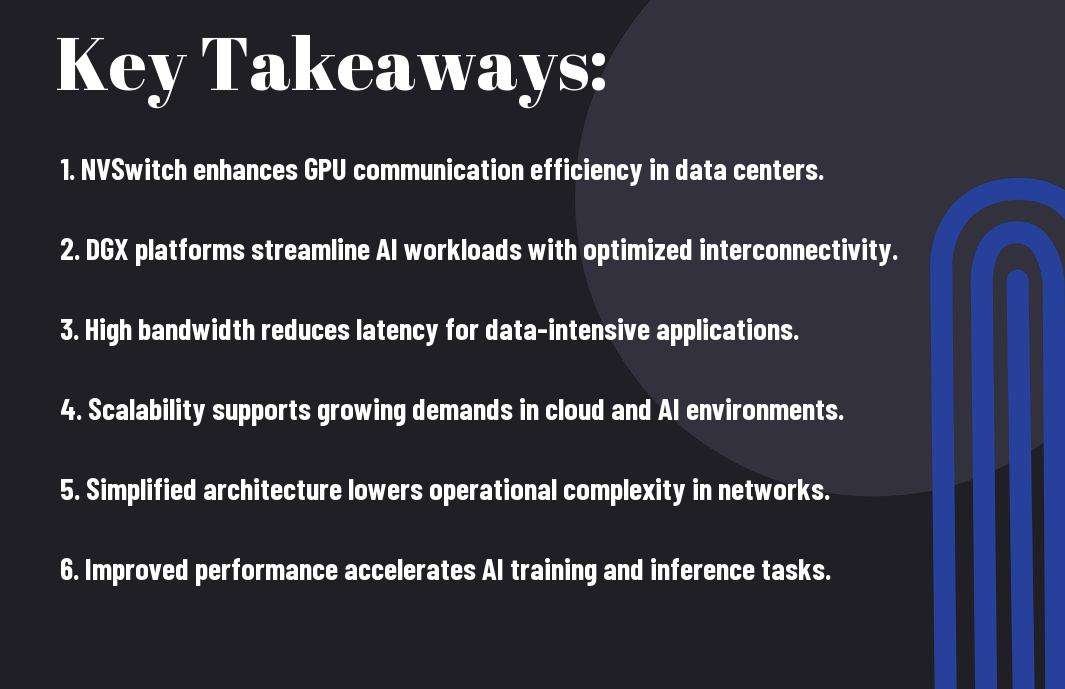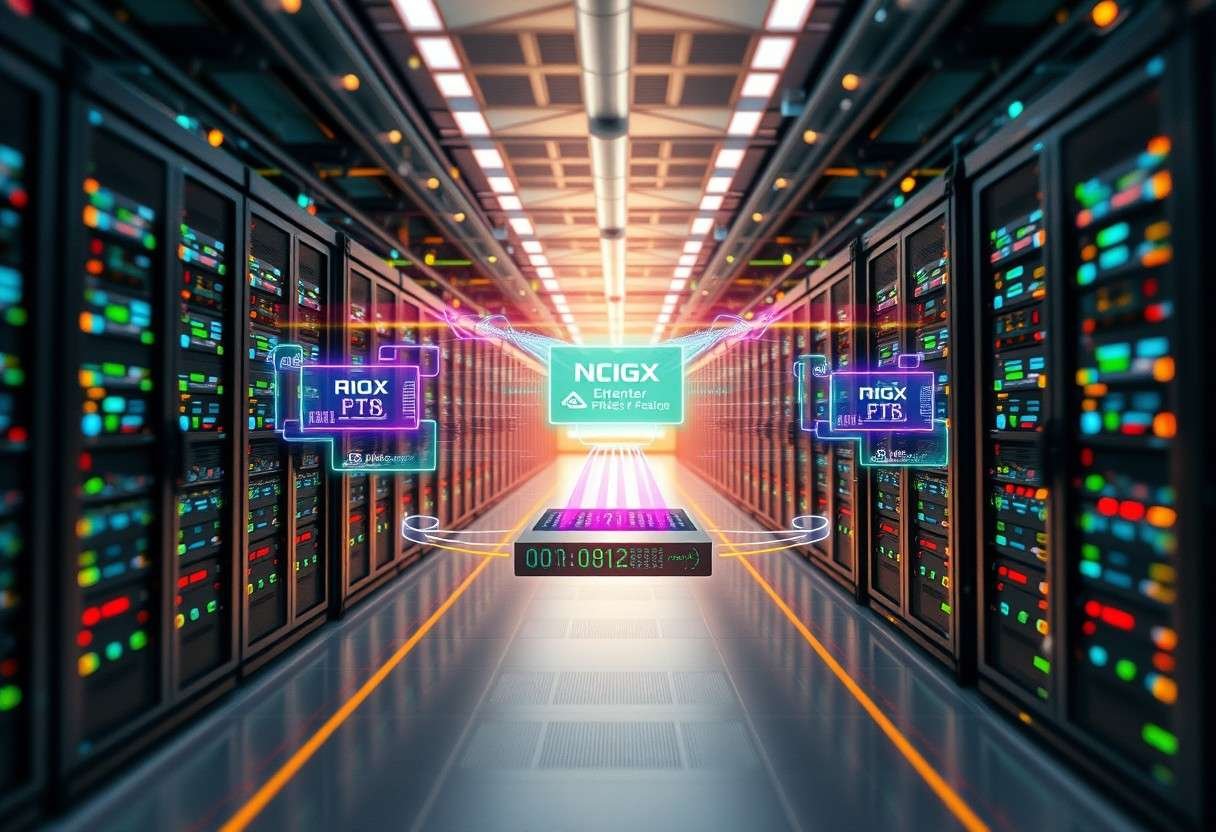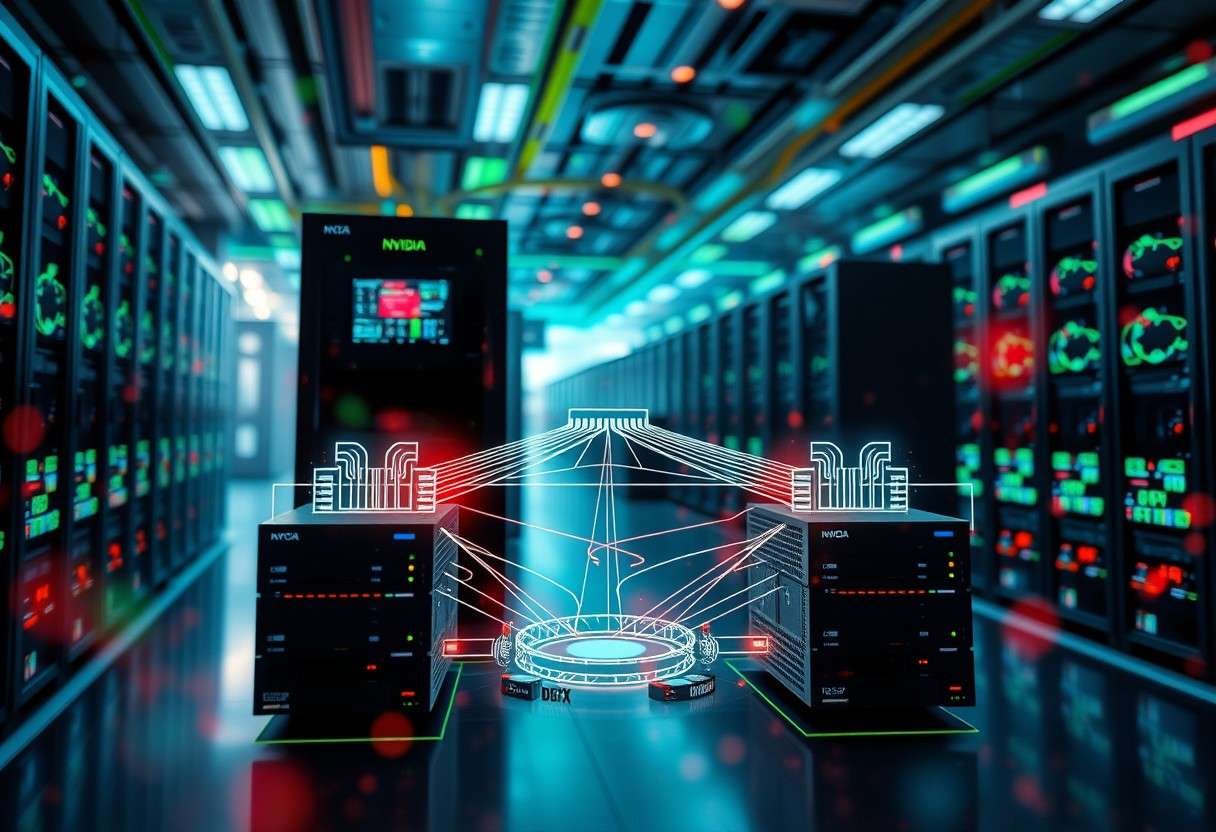Networking is evolving rapidly, and understanding how NVSwitch and DGX platforms can revolutionize your data center operations is crucial. By leveraging these cutting-edge technologies, you can enhance performance and scalability while effectively managing your workloads. The NVSwitch architecture enables higher bandwidth and lower latency connections, fostering seamless communication between GPUs. Meanwhile, DGX platforms offer optimized integrated systems that facilitate AI and deep learning applications. In this post, you’ll discover how these innovations not only boost your data center’s efficiency but also prepare you for future demands.
Key Takeaways:
- Enhanced Performance: NVSwitch technology significantly boosts data throughput and reduces latency, enabling faster communication between GPUs within DGX systems.
- Scalability: DGX platforms equipped with NVSwitch allow data centers to easily scale their GPU resources, accommodating both small and large workloads effectively.
- Optimized Resource Utilization: NVSwitch enables dynamic resource allocation and sharing among GPUs, enhancing efficiency and maximizing the utilization of hardware resources.
- Improved Management: The integration of NVSwitch in DGX systems simplifies network management and monitoring, providing IT teams with better control over data center operations.
- Future-proof Architecture: The combination of NVSwitch and DGX platforms positions data centers for future growth with support for emerging AI, machine learning, and high-performance computing workloads.


Understanding NVSwitch Technology
Your journey into the world of NVSwitch technology will bring you closer to understanding how data center networking is evolving, especially when combined with the revolutionary capabilities of the DGX Platform. This transformative technology is designed to enhance the performance and efficiency of multiple GPUs working in tandem. By comprehending NVSwitch, you will get a clearer picture of the future and the potential it holds for data-intensive applications such as AI and deep learning.
What is NVSwitch?
One of the core innovations in the NVIDIA DGX Systems is the NVSwitch, a high-speed interconnect technology that facilitates communication between multiple GPUs. Unlike traditional switch technologies, NVSwitch enables all-to-all GPU connectivity, effectively eliminating bandwidth bottlenecks. This means that data can be transferred much more rapidly, crucial for applications that rely on quick processing of vast datasets.
Architecture of NVSwitch
NVSwitch utilizes a unique architecture that fosters improved performance and scalability. With multiple NVSwitch chips, each connected to multiple GPUs, this technology allows for flexible scaling of GPU resources as your data center needs grow. Because of the high bandwidth offered by NVSwitch, GPUs can operate cohesively, enabling extreme parallel processing capabilities that dramatically enhance computational power.
Another crucial aspect of NVSwitch’s architecture is its ability to maintain low latency during intense data transfers. By offering a network topology that interacts with GPUs in a more direct manner, NVSwitch minimizes the delays typically associated with data movement. This design ensures high efficiency in computing tasks, making it particularly well-suited for complex data operations prevalent in modern AI training scenarios.
Key Features of NVSwitch
Architecture isn’t the only strength of NVSwitch; it also boasts a wide array of key features that enhance its utility in data center environments. With its superior design, NVSwitch enables organizations to maximize their computational resources with the following key features:
- All-to-All Connectivity: This ensures that each GPU can communicate with every other GPU, facilitating faster data transfer.
- High Bandwidth: NVSwitch provides exceptional bandwidth, which is crucial for managing large datasets efficiently.
- Low Latency: The technology helps in reducing the time delays in data movement, creating a seamless experience.
- Scalability: The NVSwitch architecture allows for easy scaling of resources to meet growing demands.
- Optimized Workloads: NVSwitch aids in distributing workloads across GPUs effectively, enhancing overall performance.
Any organization leveraging NVSwitch will find these features integral to elevating their data processing capabilities.
The comprehensive features embedded in NVSwitch make it a cornerstone technology for maximizing performance in data centers. With its sophisticated capabilities, organizations can tap into powerful computing resources while maintaining control over workflow efficiency. This makes NVSwitch an invaluable asset for enterprises aiming to stay ahead in the data-centric landscape.
Benefits of NVSwitch in Data Centers
Benefits abound when you integrate NVSwitch into your data center architecture. The most significant impact is seen in the boost to performance across vast arrays of GPUs, making it necessary for applications that rely heavily on computational resources, such as machine learning and data analytics. By utilizing NVSwitch, you are able to reduce the communication overhead between GPUs, allowing for faster data processing and improved application response times.
NVSwitch also leads to improved resource utilization within your data center. It creates a more efficient environment where workloads can be balanced effectively across GPUs, minimizing idle times and enhancing overall throughput. Moreover, as your organizational needs grow and you require increased computational power, NVSwitch’s inherently scalable design allows for easy expansion without having to reinvent your entire infrastructure.
As you explore NVSwitch technology for your data center, it becomes clear that the advantages it offers—such as enhanced performance, scalability, and resource optimization—are pivotal in embracing the demands of modern computational tasks. Leveraging these benefits will empower you to stay proactive in the ever-evolving landscape of data processing.
DGX Platforms Overview
All enterprises looking to leverage the power of data-driven insights are increasingly turning to DGX platforms. These systems, designed by NVIDIA, are engineered specifically to facilitate deep learning applications, providing the required computational power to handle complex AI algorithms and data sets. As machine learning and artificial intelligence continue to gain traction, understanding the fundamentals of DGX platforms is crucial for optimizing your data center networking.
What are DGX Platforms?
On the surface, DGX platforms represent more than just standard server systems; they are purpose-built supercomputers that combine powerful GPUs with innovative software. Designed to accelerate artificial intelligence workflows, DGX platforms enable deep learning researchers and data scientists to train models faster and more efficiently. With this technological advancement, you can simplify your data processing needs and scale operations more effectively.
Components of DGX Platforms
An intricate combination of hardware and software makes up the DGX platforms, ensuring optimal performance. Key components include high-throughput GPUs, high-speed interconnects, and integrated software stacks designed for deep learning. The advanced architecture of these components permits unprecedented levels of data processing, cooling, and power efficiency, which enhances your overall productivity in tackling AI projects.
For instance, a typical DGX system comprises NVIDIA A100 Tensor Core GPUs, NVLink for data communication, and deep learning frameworks like TensorFlow built to work seamlessly with these systems. This architecture allows for maximum utilization of GPU resources, minimizing bottlenecks and expediting your computational needs.
Types of DGX Systems
An array of DGX systems exists to cater to various computational needs and use cases within your organization. Here’s a breakdown of the primary types of DGX systems available in the market today:
| DGX Station | Workstation for individual AI researchers |
| DGX A100 | Modular, multi-GPU server for data centers |
| DGX SuperPOD | Scalable supercomputing platform for enterprises |
| DGX Cloud | Cloud-based AI development and training |
| DGX-1 | First-generation platform aimed at deep learning |
Any organization can consider these systems based on the AI projects you plan to undertake and the scale of your data operations. Notably, each type comes with distinct capabilities tailored to specific goals, allowing you to choose the best fit for your needs.
Platforms like DGX systems have proven vital in environments that require real-time data analytics and machine learning. They cater to industries ranging from healthcare to finance and autonomous driving — adapting to the growing complexity and volume of data you might need to process regularly.
Use Cases for DGX Platforms
Platforms such as DGX are versatile and capable of addressing a myriad of use cases in your organization. From research and development to predictive analytics, DGX systems empower you to enhance productivity and effectiveness in AI tasks. In the context of machine learning, businesses can leverage these platforms for faster model training, improved computational speeds, and seamless data integration for their applications.
Systems like the DGX A100 are particularly beneficial for complex simulation workloads and immersive virtual environments, allowing advanced graphics applications to flourish. As you aim for increased efficiency and responsiveness in your computational demands, these systems become a cornerstone for achieving significant breakthroughs in your projects.
Conclusively, by selecting the appropriate DGX platform based on your specific needs and operational goals, you can ensure your organization remains at the forefront of AI advancements. Any step you take toward integrating these powerful systems can yield significant productivity, efficiency, and innovative potential.
The Role of NVSwitch in DGX Systems
Now, let’s examine into the pivotal role NVSwitch plays in DGX systems, enhancing their capabilities and transforming the landscape of data center networking. By interconnecting multiple GPUs in a single system or across multiple systems, NVSwitch facilitates unprecedented bandwidth and low latency communication, which is crucial for handling today’s demanding workloads. This integration is particularly significant as AI and machine learning applications continue to evolve, requiring more computational power and faster data processing rates.
Architecture Integration
The innovative architecture of NVSwitch allows for a seamless integration of high-performance GPUs into your data centers. With its unique design, NVSwitch acts as a high-speed interconnect that links multiple GPUs, enabling them to communicate more effectively and efficiently than traditional PCIe connections. This architecture not only optimizes resource allocation but also simplifies the process of scaling out your AI workloads across numerous GPUs.
As you consider deploying DGX systems, understanding this architectural integration is key. The NVSwitch architecture allows you to create a powerful computing environment that maintains high throughput and low latency, optimizing your workload performance and ensuring quality service delivery to your users.
Enhanced Communication between GPUs
The enhanced communication capabilities provided by NVSwitch significantly improve the interaction between GPUs within DGX systems. This is critical because many AI tasks depend on the rapid exchange of data between numerous GPU units. NVSwitch provides a robust framework that supports this shared communication, effectively allowing you to undertake larger and more complex computations without the bottlenecks traditionally associated with data movement.
When you leverage NVSwitch in DGX platforms, you’re not just optimizing communication; you’re revolutionizing the way computations are performed in your data center. This has substantial implications for your organization, enabling you to process vast datasets with greater speed and efficiency while ensuring your applications can scale in response to growing demands.
It is also necessary to highlight how NVSwitch’s architecture minimizes latency and maximizes data throughput. This ensures that your DGX systems can handle data-intensive tasks more adeptly, resulting in quicker insights and improved decision-making processes. You can rest assured that your infrastructure is equipped to meet the challenges of modern enterprise workloads.
Scalability and Performance Improvements
NVSwitch is integral to delivering scalable performance improvements in DGX systems. By allowing multiple GPUs to interconnect, NVSwitch facilitates scalable AI and machine learning workloads, enabling you to expand your computational resources effortlessly as your organizational needs grow. This means you can deploy more powerful solutions without being constrained by traditional networking architectures, thereby enhancing overall system performance.
Your ability to scale with NVSwitch means that as datasets grow in size and complexity, your systems can adapt without significant reinvestments in infrastructure. This adaptability is vital in ensuring sustained performance, allowing you to deliver high-quality outcomes without diminishing returns in productivity.
Role of NVSwitch in DGX systems cannot be overstated, as it fundamentally enhances both scalability and performance. With NVSwitch, you can maximize your existing hardware’s capabilities while enabling easy upgrades in response to emerging technology trends or increased business demands.
Fault Tolerance Features
Integration of NVSwitch into your DGX architecture provides enhanced fault tolerance features that are crucial for maintaining system reliability. The distributed nature of NVSwitch ensures that even if one component fails, others can continue functioning seamlessly. This resilience is necessary for critical workloads that cannot afford downtime, enabling you to maximize uptime and service reliability.
Emphasizing fault tolerance allows you to maintain business continuity and operational efficiency, a top priority for any forward-thinking organization. With NVSwitch in place, your DGX systems can sustain their performance levels even in the face of hardware failures or network issues, providing you with the peace of mind that your data processing capabilities are secure.
Performance stability is enhanced significantly with NVSwitch’s fault tolerance features. You can rely on your DGX systems to keep running smoothly, thereby making your AI and machine learning processes more resilient and dependable. This ultimately translates into greater efficiency and reduced risk for your organizational operations.
Transformative Impact on Data Center Networking
For data centers navigating the complexities of modern networking, the introduction of NVSwitch and DGX platforms has been a game changer. These technologies are enabling organizations like yours to achieve unprecedented levels of performance, resilience, and scalability. They work in harmony to enhance your networking capabilities, allowing for seamless data workflows and facilitating a robust infrastructure that meets the demands of today’s data-centric applications.
Improved Data Transfer Rates
The integration of NVSwitch technology significantly boosts data transfer rates within data center environments. With NVSwitch, you gain a powerful, non-blocking network architecture that can accommodate high-speed data exchanges between GPUs and other computing resources. This capacity not only allows for faster computation but also helps streamline data handling processes, allowing you to execute complex tasks much quicker than was previously possible.
Additionally, DGX platforms are designed to optimize these data transfer capabilities, making it easier for you to manage large datasets effortlessly. The synergy between NVSwitch and your existing infrastructure enriches your data processing capabilities while minimizing bottlenecks, significantly enhancing overall system performance.
Reduced Latency in Data Processing
One of the critical benefits of deploying NVSwitch and DGX platforms in your data center is the marked reduction in latency during data processing. Traditional networking methods often introduce delays in communication between different nodes, hampering speed and efficiency. However, with NVSwitch, you can achieve near-instantaneous connectivity, facilitating real-time data access for computation and analysis.
This miraculous decrease in latency allows you to handle live data streams and complex computations smoothly, offering performance improvements that can impact workflow considerably. Your applications can now respond faster, enabling you to make timely and informed decisions that are crucial for your business success.
Latency is particularly critical in scenarios where decisions hinge on real-time data, such as in financial services or autonomous driving. By minimizing lag, you can significantly enhance your operational responsiveness, ensuring that your business maintains a competitive edge.
Enhanced Computing Efficiency
Any organization looking to improve its computing efficiency can benefit greatly from the integration of NVSwitch with DGX systems. The technologies allow you to balance workloads effectively across multiple GPUs, leading to optimized resource utilization and quicker completion of tasks. This efficient distribution of tasks results in lower operational costs and higher productivity for your team.
Furthermore, the effectiveness of GPU sharing means that your overall system can achieve more with less, allowing you to scale your operations without the need for substantial investments in additional hardware. This contributes to a more sustainable approach to computing that is beneficial both economically and environmentally.
With NVSwitch and DGX, you can not only achieve peak performance but also maintain a finely tuned system that adapts to your changing needs, giving you the flexibility to address future demands with ease.
Streamlined Resource Management
Processing resources in a data center can often lead to complexities and inefficiencies, especially in large-scale environments. NVSwitch aids in alleviating these challenges by providing a unified network architecture that simplifies resource management. This simplification allows you to manage and allocate resources more efficiently, ensuring your operations run smoothly without unnecessary overhead.
By leveraging these advanced technologies, you can monitor and adjust resource allocations on-the-fly, tailoring your infrastructure to align perfectly with the current workload. This flexibility not only saves you time but also empowers your teams to focus on innovation rather than routine management tasks.
It becomes even easier to manage resources when you have a centralized view of your data center’s configuration. You can dynamically adjust resources to match application demands, enhancing performance and enabling you to deploy new projects more efficiently.
Comparison with Traditional Networking Solutions
Many data centers have relied on traditional networking solutions for years, but as demands for higher performance and efficiency increase, it’s imperative to understand the differences and advantages offered by modern technologies such as NVSwitch and DGX platforms. Below is a comparative overview of traditional networking solutions and their newer counterparts.
Comparison Table
| Aspect | Traditional Networking Solutions |
|---|---|
| Architecture | Hierarchical with multiple tiers and potential bottlenecks |
| Scalability | Limited; often requires extensive redesign when scaling |
| Performance | Slower data rates, often hindering large-scale AI tasks |
| Flexibility | Rigid architecture, sometimes difficult to adapt to new workloads |
| Cost Effectiveness | Higher operational costs due to inefficiencies |
Limitations of Traditional Models
To effectively assess how NVSwitch and DGX platforms excel, it’s critical to recognize the limitations of traditional networking models. These conventional solutions often struggle with scalability and performance, leading to bottlenecks that inhibit data transfer rates. As your data center scales up, the traditional hierarchical architecture can create significant challenges, resulting in heightened latency and reduced throughput.
Moreover, traditional architectures tend to be rigid and inflexible, making it difficult to adapt quickly to evolving business needs or the introduction of cutting-edge technologies. This lack of agility can hinder your organization’s ability to remain competitive in today’s fast-paced digital landscape, where responsiveness is key.
Performance Benchmarks
Traditional networking solutions have long struggled to meet the demands of modern data centers. With their hierarchical structure, they often fall short on performance benchmarks compared to NVSwitch and DGX systems. These conventional models may exhibit higher latency and limited bandwidth, making them inadequate for handling large-scale shared workloads or real-time data processing.
It is imperative for you to understand that while traditional networking might handle basic computational tasks, it lacks the high-speed interconnects and optimized routing capabilities that NVSwitch brings. The result is an environment where performance lags, affecting your ability to effectively process and analyze big data efficiently.
Importantly, high-performance benchmarks provided by NVSwitch and DGX platforms are designed to push the limits of data processing and make the most of available resources. This allows you to achieve faster computational speeds, which can translate into reduced time-to-insight and improved operational efficiency.
Flexibility and Adaptability
Traditional networking solutions often lack the required flexibility and adaptability you need to keep pace with emerging technologies and workloads. Their static architecture makes it challenging to seamlessly integrate new servers, storage, or applications, ultimately stifling your ability to innovate and adapt in a rapidly changing market.
Flexibility in data center networking is vital for your ability to scale and evolve. As projects grow and new opportunities arise, not having a network that can adjust quickly can significantly hamper your operational efficacy. This is where NVSwitch and DGX platforms truly shine, offering a modular approach that seamlessly integrates with your existing infrastructure.
Flexibility in your data center network allows you to quickly pivot your resources according to project demands, maximizing the efficiency of your operational processes.
Future-proofing Data Center Investments
For anyone overseeing a data center, it’s pivotal to consider future-proofing your investments. As technologies continue to evolve, ensuring that your networking solution can easily adapt to future demands is imperative for sustained success. Traditional networking models often lead to costly overhauls as new requirements emerge, whereas NVSwitch and DGX platforms are designed with future scalability in mind.
This adaptable architecture not only minimizes the expensive disruptions caused by upgrading to newer systems but also instills confidence that your infrastructure can handle whatever challenges the future holds. Investing in these advanced systems enables you to be proactive in your approach, rather than reactive.
This approach helps ensure that as your requirements continue to grow and change, your data center can likewise evolve without the need for extensive rebuilding or redesigning, ultimately protecting your initial investment over time.
Security Considerations in NVSwitch and DGX
Not all data center architectures are created with security in mind. When you adopt NVSwitch and DGX platforms for your data center networking needs, understanding the security implications becomes paramount. You can learn about the broader implications of these technologies in the Nvidia enterprise AI ecosystem: GPUs to dev tools. This chapter probes into key security considerations that come with the adoption of these cutting-edge technologies, ensuring that you can maximize their potential while protecting your valuable information assets.
Built-in Security Features
Security is integrated into the NVSwitch and DGX platforms through various built-in features designed to mitigate risks and protect sensitive data. These features include advanced encryption mechanisms that safeguard data both at rest and in transit. By using hardware-based security measures, such as secure boot and trusted execution environments, these platforms help to establish a solid foundation for your data center’s security posture.
Furthermore, regular firmware updates are instrumental in addressing emerging vulnerabilities, allowing your systems to stay ahead of potential threats. By leveraging these built-in security features, you can create a more secure environment within your data center, ensuring that your network and data remain robust against unauthorized access or breaches.
Network Segmentation Techniques
One of the most effective strategies for enhancing security in your NVSwitch and DGX environments is through network segmentation techniques. By dividing your network into distinct segments, you can isolate different workloads or business units, significantly reducing the attack surface. This means if one segment is compromised, the damages can potentially be contained, preventing lateral movement of threats throughout your network.
Moreover, by carefully applying access controls and monitoring protocols across these segments, you create a layered defense that makes it considerably harder for intruders to gain full access to your data and resources. This method not only strengthens your security posture but also enhances overall network performance by minimizing congestion and optimizing bandwidth usage.
With the use of effective network segmentation, you also improve compliance with security policies, helping you to maintain a more organized and secure IT environment.
Data Privacy Protections
With the increasing amount of data being processed and analyzed through NVSwitch and DGX systems, implementing robust data privacy protections is crucial for your organization. Privacy is not just about compliance; it’s a key trust factor for your customers and stakeholders. Utilizing comprehensive data encryption techniques and ensuring that sensitive information has restricted access can significantly mitigate the risk of data breaches.
Furthermore, you may want to explore advanced user authentication methods to strengthen security protocols further. The deployment of techniques such as biometric authentication or two-factor authentication can add another layer of protection for your most sensitive data assets, ensuring that only authorized personnel have access.
Network segmentation and data privacy protections work together to create a more secure framework for handling sensitive information, ensuring trust and compliance with regulatory standards.
Compliance with Industry Standards
Considerations regarding compliance with industry standards shouldn’t be overlooked when you deploy NVSwitch and DGX systems. Many organizations face a complex landscape of regulations—ranging from GDPR to HIPAA—that demand stringent data protection and privacy practices. Being proactive in understanding these requirements ensures that your organization stays compliant and avoids potential fines or legal issues.
In particular, integrating compliance measures into your security framework, such as regular audits and continuous monitoring, can help you identify potential weaknesses in your infrastructure. Adhering to industry standards also positions your organization as a trustworthy entity, encouraging better relationships with both customers and partners.
Understanding the specific compliance requirements that pertain to your industry can significantly enhance your overall security posture, ensuring that your NVSwitch and DGX deployments not only fulfill operational needs but also align with regulatory expectations.
Conclusion
With these considerations, it’s clear that NVSwitch and DGX platforms represent a significant leap forward in data center networking. By providing a highly efficient, scalable, and optimized architecture, these technologies enable you to handle increasingly complex workloads with ease. You gain the ability to efficiently manage data flow across multiple GPU resources, facilitating faster processing and reducing bottlenecks. Your data center can now support more intensive workloads, including AI and machine learning applications, which are critical for maintaining a competitive edge in today’s fast-paced digital landscape.
Furthermore, the integration of NVSwitch with the DGX systems encourages a more interconnected environment, enabling your team to collaborate more effectively while maintaining the robustness required for heavy computational tasks. As you explore these transformative solutions, you’ll find that they not only improve your operational efficiency but also empower you to harness the full potential of your data and innovations. Embracing NVSwitch and DGX technologies can pave the way for your organization’s success in the evolving world of data-driven decision-making and cloud computing.
FAQ
Q: What is NVSwitch and how does it function in data center networking?
A: NVSwitch is a high-speed interconnect technology developed by NVIDIA that enables efficient communication between multiple GPUs in a data center. It acts as a high-bandwidth switch, allowing GPUs to connect directly and share data with minimal latency. By providing a scalable architecture, NVSwitch supports configurations with numerous GPUs, facilitating complex calculations and workloads such as AI and deep learning in data centers. Its ability to handle fast data exchanges promotes quicker processing times and enhances overall data throughput.
Q: How do DGX platforms utilize NVSwitch for AI workloads?
A: DGX platforms, like NVIDIA’s DGX A100 and DGX Station, are designed specifically for AI and deep learning workloads. They integrate NVSwitch to maximize the performance of GPU interconnectivity. With NVSwitch enabling high bandwidth and low-latency communication among GPUs, DGX systems can handle large datasets more efficiently. This seamless interaction allows for parallel processing, which significantly accelerates model training and inference tasks. As a result, DGX platforms equipped with NVSwitch are particularly well-suited for enterprises engaged in accelerated AI research and development.
Q: What advantages do NVSwitch and DGX platforms offer in terms of scalability?
A: Both NVSwitch and DGX platforms are designed with scalability in mind. NVSwitch allows for the connection of up to 16 GPUs in a single node, and multiple DGX nodes can be interconnected within a data center. This flexibility enables businesses to expand their computational resources as needed without requiring a complete overhaul of their infrastructure. The modular nature of these systems means organizations can start with a smaller number of GPUs and gradually scale up to meet growing workloads, ensuring a cost-effective and future-proof approach.
Q: Are there any specific workloads or industries that benefit the most from NVSwitch and DGX platforms?
A: Industries that demand intensive computational power, such as AI research, machine learning, quantitative finance, and autonomous vehicles, benefit significantly from NVSwitch and DGX platforms. These sectors require rapid data processing and the ability to train complex models efficiently. The high-speed interconnectivity and performance enhancements provided by NVSwitch allow businesses in these sectors to harness larger datasets, execute more calculations simultaneously, and ultimately drive innovation faster than those relying on traditional architectures.
Q: How do NVSwitch and DGX platforms improve data center efficiency and resource utilization?
A: NVSwitch and DGX platforms contribute to improved data center efficiency by enabling better resource utilization through high-performance computing. With NVSwitch facilitating low-latency communications and higher bandwidth among GPUs, data centers can run multiple AI applications concurrently without encountering bottlenecks. This means that resources are fully utilized, reducing downtime and enhancing operational efficiency. Additionally, the consolidation of hardware into fewer nodes minimizes space, power consumption, and cooling requirements, leading to a more sustainable and cost-effective data center environment.







